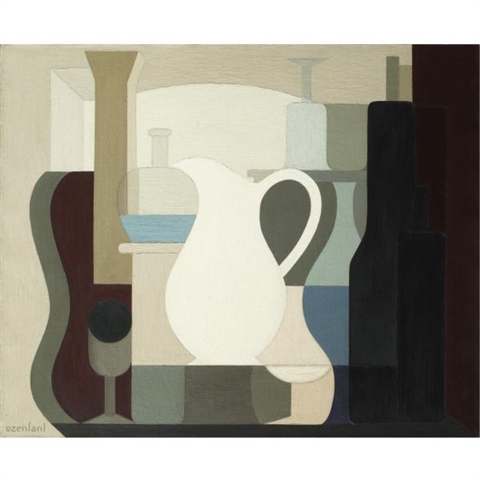PURISM
One of the styes that influenced young Rene Magritte was Purism, a variant of Cubism. Until 1925 Magritte was heavily influenced by Purism and Futurism. In 1925 he became influenced by Pre-Surrealist Giorgio de Chirico (1888-1978) who is labeled a proponent Pittura Metafisica (Metaphysical Painting/Magic Realism). Below is an article on Purism from History of Art:
Mechanization inspired many artistic and literary movements of the 20th century, sometimes in admiration and sometimes in firm opposition. The rational, objective, and disciplined aspects of machinery were recognized either as aesthetic precedents or as a threat to all that was beautiful in society. Pure functionality fascinated artists but at the same time puzzled them. Two French artists provided a response to this problematic relationship with the machine age. Under the label of Purism, they expressed their belief in the need for artistic rigour, precision, and impersonality. Both Amedee Ozenfant (1886-1966) and Charles-Edouard Jeanneret (1886-1965), later known as Le Corbusier, wanted a more rational interpretation of Cubism, beyond its literary or symbolic baggage and dynamic or decorative stimuli. Purist theory aimed to restore painting to a primitive purity in which representation would be lucid, self-evident, and geometrical. This ideal of efficiency and essentiality in art could be modelled on the aesthetics of machines and industrial technology, which the two painters recommended as a potential repertory of plastic forms.

Amédée Ozenfant, Le pichet blanc, oil on canvas, 1926
Their main aim was to provide examples of universal values such as order, austerity, and clarity. Other European movements of the time, which were also providing a positive response to the brutality, chaos, and irrationality of war. had much in common with these views. In their manifesto "Apres le Cubisme" (published in 1918), Ozenfant and Le Corbusier stated that the greatest joy of the human spirit was the perception of order and the greatest human satisfaction was to be found in helping to bring about, or being part of. this order. Their paintings were almost exclusively still lifes of domestic objects such as jugs, glasses, and pipes. Clearly delineated against a simple perspective plane, these works adhered to a "general grammar of sensibility" that simplified forms, standardized compositional relationships, and swept away accident and emotivity in favour of a synthesis of lines and chromatic fields. In October 1920, in order to disseminate their purist and rational doctrine, the two artists in conjunction with the poet Paul Dermee launched a review. L'Esprit Nouveau. which was published on a regular basis until 1925. This magazine was probably more effective in making an original contribution to the avant-garde movements in Europe than the rather repetitive and frozen paintings that were being produced by Ozentant and Le Corbusier.
Purism (Encyclopaedia Britannica)
In painting, a variant of Cubism (q.v.) developed in France in about 1918 by the painter Amédée Ozenfant and the architect and painter Charles-Édouard Jeanneret (Le Corbusier). The two artists, critical of the later decorative trend in Cubism and the creation of arbitrary and fantastic forms, advocated a return to clear, precise, ordered forms, expressive of the modern machine civilization. The collaboration of the two artists began with their book Après le cubisme, of 1918, and continued with essays published from 1920 to 1925 in their review, L'Esprit Nouveau.
In an essay entitled “Purism,” which appeared in this review, the authors defined painting as “an association of purified, related, and architectured elements.” This concept of painting is reflected in their still-life canvases, which present clean, pure, integral forms. In “Still Life” (1920), for example, Le Corbusier repeats the rhythmic, curving contours of a guitar (a favourite Cubist motif) in the shoulders of a bottle and in other objects on the table; by tilting the tops of the objects toward the spectator, he gives an added emphasis to their cubic volume. A motif of circles is carried out in the various sizes of the openings in bottles, pipes, and containers. The colour scheme is purified to include only the neutrals—gray, black, and white—and monochromes of green. Paint is smoothly applied to enhance the cool, harmonious shapes of the objects. He thus creates a “symphony of consonant and architectured forms.”
As a movement in painting, Purism did not have an appreciable following. There were many painters, however, who, like the Purists, were attracted to a machine-inspired aesthetic; most notable were the French painter Fernand Léger and the American Precisionist painters of the 1920s.